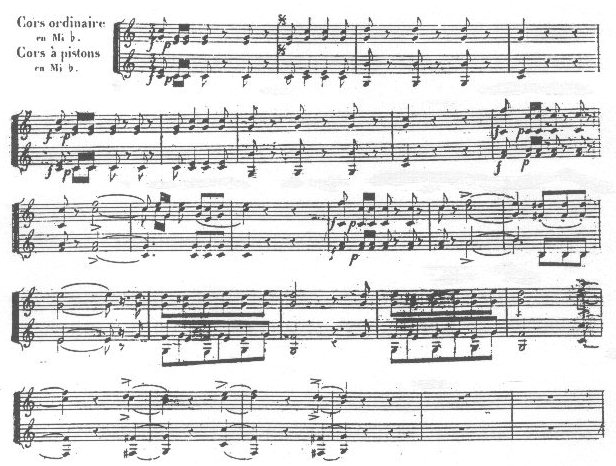The First Orchestral Use of the Valved Horn: La JuiveThe orchestral début of the valved horn John EricsonPortions of this article were published as a letter to the editor in The Horn Call Annual 7 (1995) and in my article in The Horn Call Annual 9 (1997). The orchestral début of the valved horn is the 1835 opera La Juive of Jules Halévy (1799-1862). In this work crooks are used on the valved horns in a similar manner to that seen in the Meifred Méthode. [See the article Joseph Meifred and Early Valved Horn Technique in France for more on this topic]. La Juive has frequently been noted for its use of valved horns without examining the nature of the writing [Runyan, 270]. The orchestration calls for four horns and includes parts for a pair of valved horns in seven of its twenty-two numbers; Meifred is recorded as performing one of the valved horn parts for the premiere [Carse, 76]. The following is a typical example from this work. Halévy, La Juive, Act 1, no. 5, mm. 1-24. It can be seen that the valved horns are treated differently than the natural horns. They are used to play numerous tones in the lower range which would have to be taken as covered pitches on the natural horn, including f, f-sharp, b, f' and a'; these pitches are clearly intended to be taken as open pitches using the valves, as evidenced by the voice crossings in measures nine and thirteen required to place these pitches in the valved horn parts. It is clear from the orchestration of this work that Halévy employed the valved horns, pitched in several keys, primarily as fully chromatic instruments which performed principally in the low range. Halévy called for valved horns crooked in the keys of D, E-flat, E, and G, with E-flat being the most common. From the notation of the part one sees that the third and fourth horns are to switch frequently between natural and valved horns; natural horns are requested of these players in seventeen numbers, and they are to switch between valved and natural horns during the course of four numbers. Crooks requested in the natural horn sections for the third and fourth horns include B-flat basso, C, D, E-flat, E, F, G, and A. As Halévy clearly expected the hornists to make these changes of crooks on the natural horn, it follows that he also expected the hornists to change crooks on the valved horn as requested in the score; the valved horn was not seen as a fixed pitch instrument in F, as it would come to be later, and was placed in keys which Halévy believed would allow the greatest ease of performance. The choice of crooks in a more restricted range of keys from D to G would additionally allow for the proper adjustment of one set of valve slides for each crook. [See Berlioz's comments on this topic in the article Berlioz on the Valved Horn]. This style of writing for valved horns in several different pitches is of considerable importance with regard to early German valved horn writing as well, as the opera La Juive is known to have been a significant influence upon Richard Wagner [Westernhagen, vol. 20, 105]. Wagner himself commented favorably on the work in a review of a production of Halévy's later opera La reine de Chypre (1841) [Snedeker, "Early," 11-12]. [See the related article, J. R. Lewy and Early Works of Wagner]. A final note on Halévy's orchestration in this work. There is a number, Act V, no. 21, which requests two "Cors a piston in LA." These parts require additional brass players which perform only in this number; the four horns are all playing natural horns at this point in the orchestration and have their own parts to play. Runyan, 272, states that these are also valved horn parts. While this passage was additionally cited as an orchestral horn excerpt in volume 3 of the most important nineteenth-century collection of horn excerpts, Friedrich Gumbert [sic], Solobuch für Horn (Leipzig: Merseburger, [ca. 1874-79]), 26, the style of writing and the location of the part in the score above the staves of trumpets, not with the horns, together tend to indicate that the parts in question are actually valved cornet parts. SOURCES Adam Carse, The Orchestra From Beethoven to Berlioz (New York: Broude Brothers, 1949), 76, citing Castil-Blaze, L'Académie Impérial de Musique (Paris, 1855), vol. 2, 347. Halévy, Jacques-François, La Juive (Paris: Schlesinger, n.d.; reprint, Gossett, Philip and Charles Rosen, eds., Early Romantic Opera, vol. 36, New York: Garland, 1980). William Edward Runyan, "Orchestration in Five French Grand Operas" (Ph.D. diss., University of Rochester, 1983). Jeffrey L. Snedeker, "The Early Valved Horn and its Proponents in Paris 1826-1840," The Horn Call Annual 6, (1994), 6-17. Curt von Westernhagen, "Wagner, Richard," The New Grove Dictionary of Music and Musicians, Stanley Sadie, ed. (London: Macmillan Press Ltd., 1980), vol. 20, 105. Copyright John Ericson. All rights reserved. |
